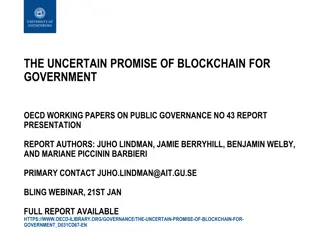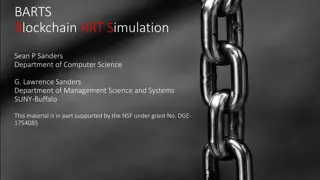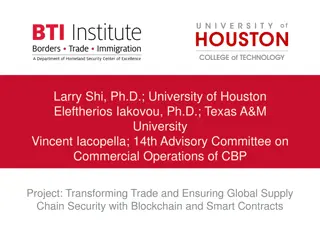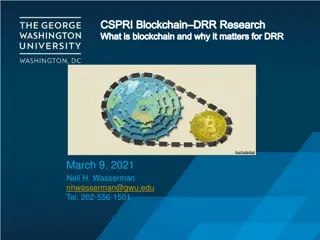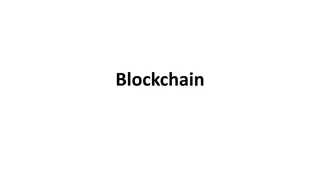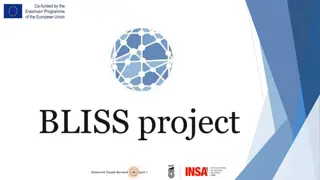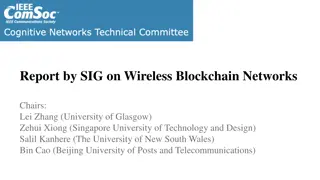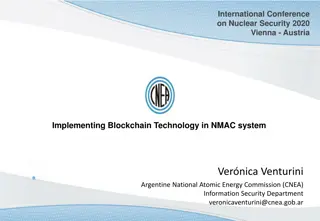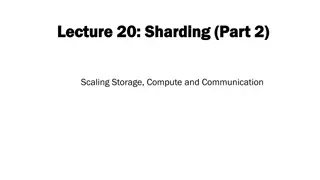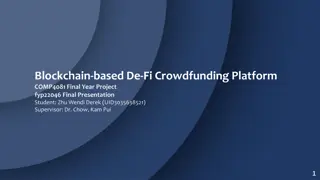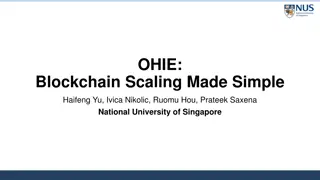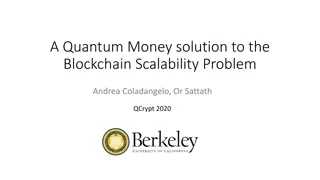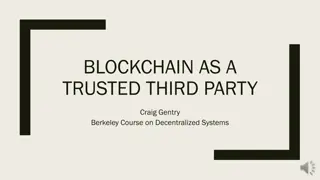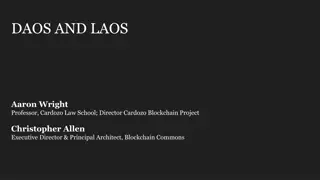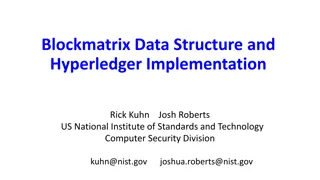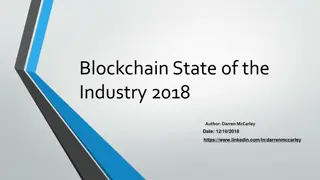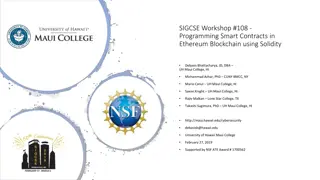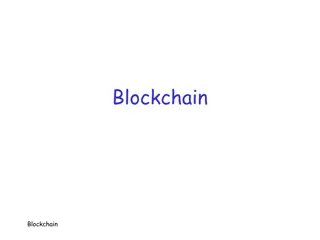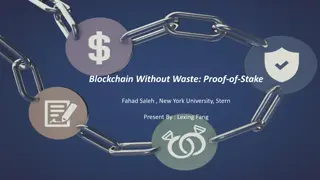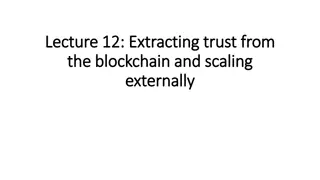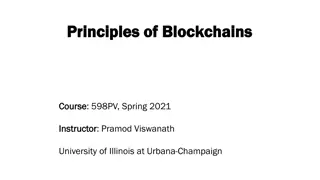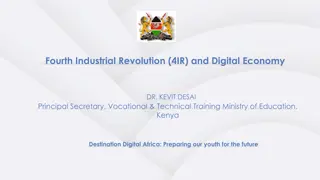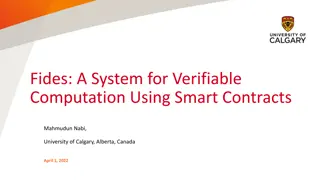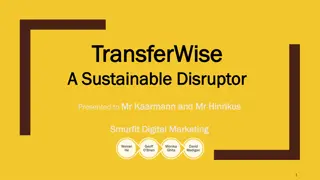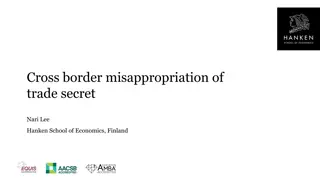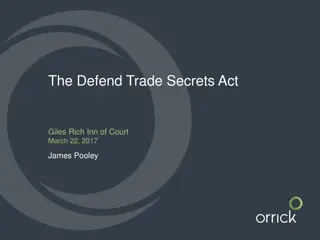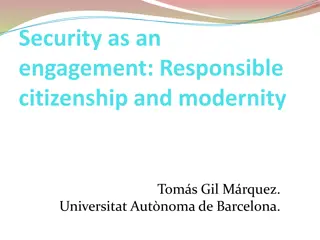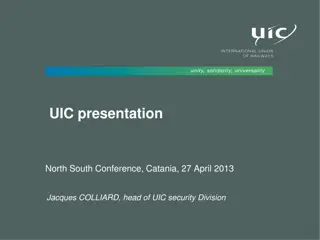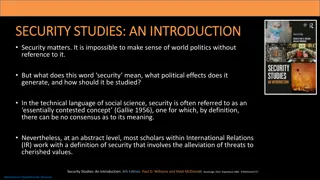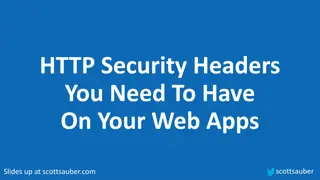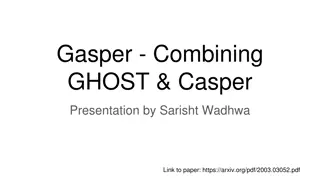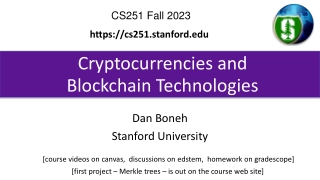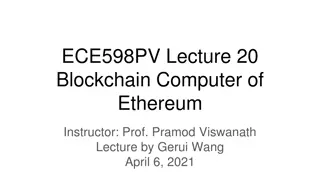Secrets on Public Blockchain: Security and Efficiency
Exploring the challenges of maintaining secrecy on a public blockchain, this study emphasizes the importance of proactive secret-sharing protocols to safeguard sensitive information from adversaries while ensuring efficiency and scalability. The research delves into the complexities of keeping secrets on a blockchain network, discussing strategies like anonymous committee members and proactive resharing mechanisms to protect confidential data effectively.
- Blockchain Security
- Proactive Secret-Sharing
- Public Blockchain
- Scalability Challenges
- Secret-Keeping
Download Presentation

Please find below an Image/Link to download the presentation.
The content on the website is provided AS IS for your information and personal use only. It may not be sold, licensed, or shared on other websites without obtaining consent from the author. Download presentation by click this link. If you encounter any issues during the download, it is possible that the publisher has removed the file from their server.
E N D
Presentation Transcript
1 3 2 CAN A BLOCKCHAIN KEEP A SECRET? Fabrice Benhamouda1, Craig Gentry1, Sergey Gorbunov2, Shai Halevi1, Hugo Krawczyk1, Chengyu Lin3, Tal Rabin1, Leonid Reyzin2 https://eprint.iacr.org/2020/464
Can a Blockchain be a Trusted Party? Public PoS ?1 This Photo by Unknown Author is licensed under CC BY-NC-ND ?(?1,?2,?3) ?2 ?3 Meh Great for integrity/immutability Not so much for secrecy
This Work: A Basic Secrecy Setting A client deposits a secret at the blockchain To be revealed only when the time is right More generally used only in the prescribed manner Example: publish a puzzle, deposit a solution Reveal the solution if not found by next week Can form the basis for many applications
Security and Efficiency The secret must remain a secret Unknown to the adversary, but still recoverable As long as we have honest majority of stake Even when the adversary is mobile Efficiency: want a scalable solution Communication/work does not increase as time go by, or as more nodes are joining the network Plausible practicality: No obfuscation/witness-encryption We seek solutions based on proactive secret-sharing
Proactive Secret-Sharing [OY91,CH93,] Periodic runs of a share-refresh protocol reshare reshare reshare reshare ?1 ?2 ?3 ?4 The secret remains a secret as long as each committee separately has honest majority Even if different parties are corrupted in different times
Why is it Hard on a Public Blockchain? For scalability, communication only by a small committee But then a mobile adversary can corrupt them all Previous work assumed assumed that committees have honest majority We provide a mechanism to ensure it Solution: keep committee members anonymous So adversary cannot target them Player replaceability: Player replaceability: a committee member sends a single message, revealing its identity only after completing its job How to (re)share a secret among an unknown committee? only after completing its job
Some Directions that do not Work The secret-sharing committee self-selects (via sortition) Previous committee doesn t know who to pass the secret to ? reshare Each committee member selects its successor Corrupted members will always corrupt their successors Honest members will choose a corrupted successor w/ prob. ? Committee will have a dishonest majority soon enough reshare reshare reshare reshare ?3 ?4 ?1 ?2
Wouldnt it be great if we had A target-anonymous channel functionality ?visible input ports, ? hidden output ports Random assignment of the output ports to an ?-subset of the ? users ?1 ?2 ?1 ?3 ?2 ?4 ?3 ?5 ?6 ?? ??
Wouldnt it be great if we had A target-anonymous channel functionality ?visible input ports, ? hidden output ports Random assignment of the output ports to an ?-subset of the ? users Anyone can send on the ? th input port, not knowing who will receive the message Current committee can re-share the secret using the ? input ports Shares sent to a new random committee ?1 ?2 ?1 ?3 ?2 ?4 ?3 ?5 ?6 ?? ??
Wouldnt it be great if we had A target-anonymous channel functionality ?visible input ports, ? hidden output ports Random assignment of the output ports to an ?-subset of the ? users Anyone can send on the ? th input port, not knowing who will receive the message Current committee can re-share the secret using the ? input ports Shares sent to a new random committee ?1 ?2 ?1 ?3 ?2 ?4 ?3 ?5 ?6 Doesn t solve everything, but helps a lot ?? ??
Tools Cryptographic sortition (using verifiable random functions) Allows a committee to self-selects Members can prove that they were selected PKI and a broadcast channel Both provided by the blockchain Anonymous public-key encryption Given ???,???,??, , hard to tell under which ??? it was encrypted
Approximating Target-Anonymous Channels An ?-member nominating committee self-selects Each nominator ??: Chooses a nominee ?? among the ? parties At random if the nominator is honest Draws a new key pair ??? Encrypts ??? Using anonymous PKE anonymous PKE, ??? does not betray ?? Broadcasts the pair (??? Everyone can encrypt/broadcast messages under ??? ?? can recover ??? ,??? ?????? $ under the public key of ?? to get ??? ????????? ,???) and then decrypt
Nominators Need Not Prove Anything Corrupted nominators can (e.g.) nominate their friends Proofs wouldn t have worked anyways: Even if forced to behave honestly, a corrupted nominator could turn around and corrupt its randomly-chosen nominee Also: such proofs have long statements Statements that include everyone s public keys So producing the proof is not scalable
Resilience of Our Target-Anonymous Channels If adversary controls ?-fraction of the stake/parties Then it controls ?-fraction of the nominators Corrupted nominators choose corrupted nominees Honest nominators choose corrupted nominees w.p. ? Chosen committee will have 2?-fraction corruptions To ensure honest majority of the chosen committee, we need to assume ? < 1 4
The Overall Solution ?1 ?2 ?3 ?4 Nominating committees reshare reshare reshare reshare Secret-sharing committees ?1 ?2 ?3 ?4 Re-sharing requires NIZK Only for short statements with short witnesses Depends only on the committee size Hence solution is scalable
The End Result A scalable proactive secret-sharing protocol With player replaceability Assuming that the adversary controls < of the stake Room for improvement here Can be implemented under DDH, DCR, LWE, Requires anonymous encryption under selective opening attacks An open problem, see following slides Can conceivably be made practical
Anonymous PKE Under Selective Opening Our solution broadcasts encryptions under anonymous PKE Adversary sees pks, ctxts, then decides who to corrupt Can an adversary that only corrupts ?-fraction of keys, nonetheless manage to read ? fraction of the ctxts? ? ciphertexts ? public keys
Anonymous PKE Under Selective Opening Our solution broadcasts encryptions under anonymous PKE Adversary sees pks, ctxts, then decides who to corrupt Can an adversary that only corrupts ?-fraction of keys, nonetheless manage to read ? fraction of the ctxts? Can an adversary that corrupts < ? ? keys hit many more than ? ? blue keys? Even though they are computationally hidden ? ciphertexts ? public keys
Anonymous PKE Under Selective Opening An adaptive adversary sees keys, ciphertexts, then opens keys one at a time Semi adaptive decides on the set of keys to open at once Rather than one at a time For secrecy secrecy, it is known that semantic security does not imply secrecy under selective opening Even for semi-adaptive adversaries
Anonymous PKE Under Selective Opening An adaptive adversary sees keys, ciphertexts, then opens keys one at a time Semi adaptive decides on the set of keys to open at once Rather than one at a time Lemma: anonymous PKE anonymous PKE semi opening opening ?? keys, cannot open much more than keys, cannot open much more than ?? ciphertext ciphertext- -encrypting keys encrypting keys except with negligible probability Conjectures: the same holds for fully adaptive semi- -adaptive adversary adaptive adversary
Some Open Problems and Future Work Prove the anonymous-PKE/selective-opening conjecture Do more with the secret Don t just keep it, compute on it (in the pipeline) Improve resilience of target-anonymous channels From ? < 1 4, hopefully to While keeping it scalable Implement this solution ? < 1 2


